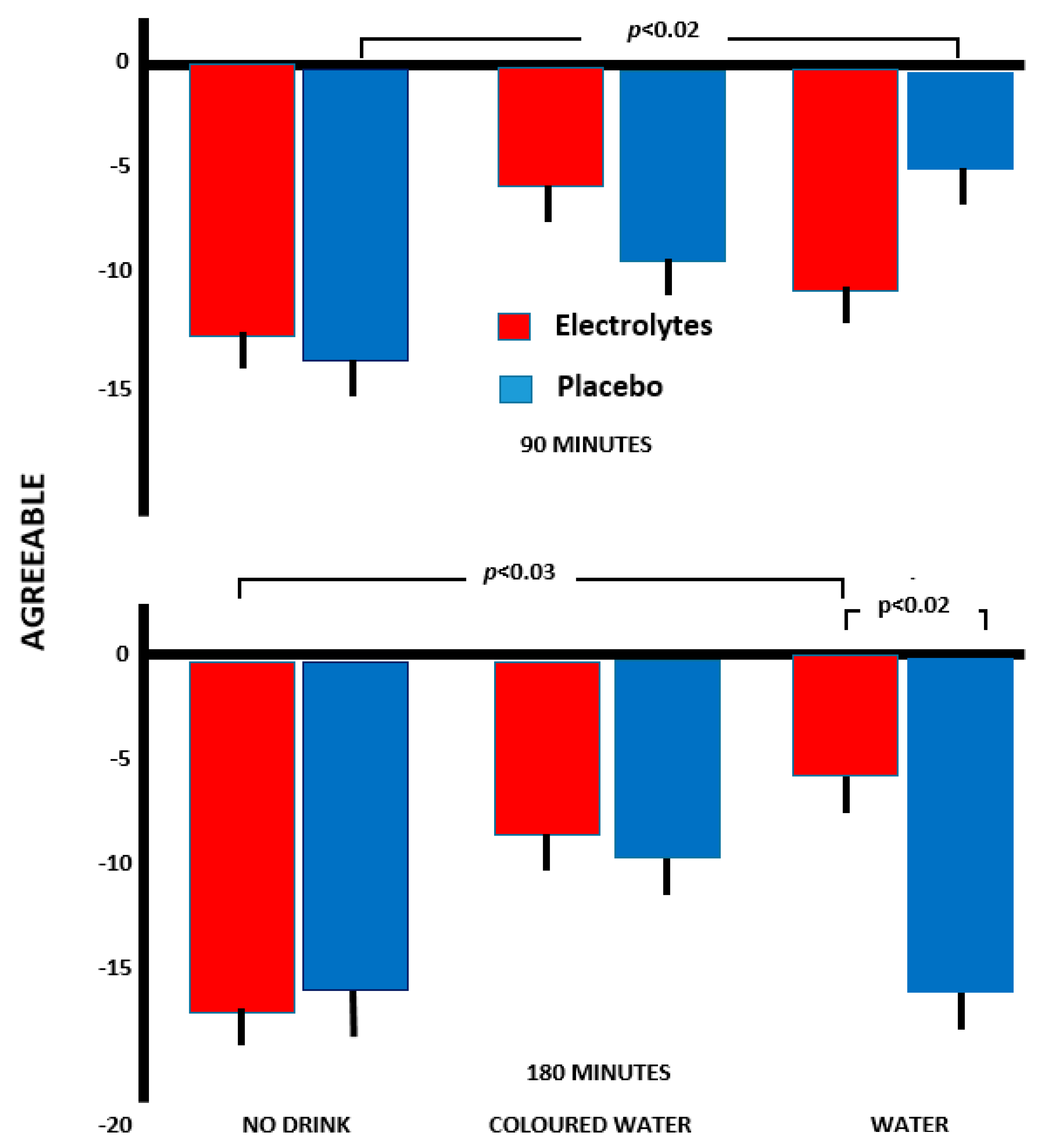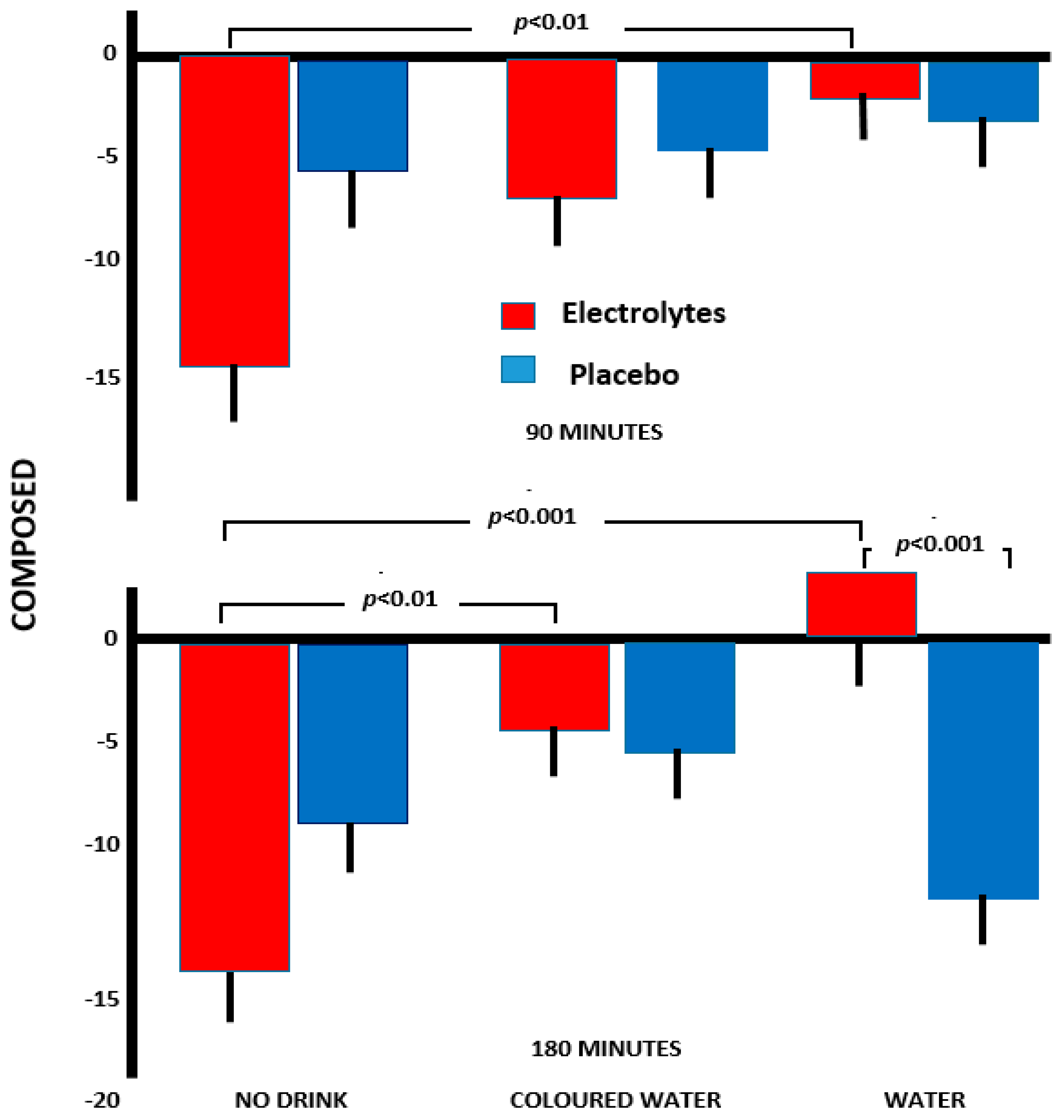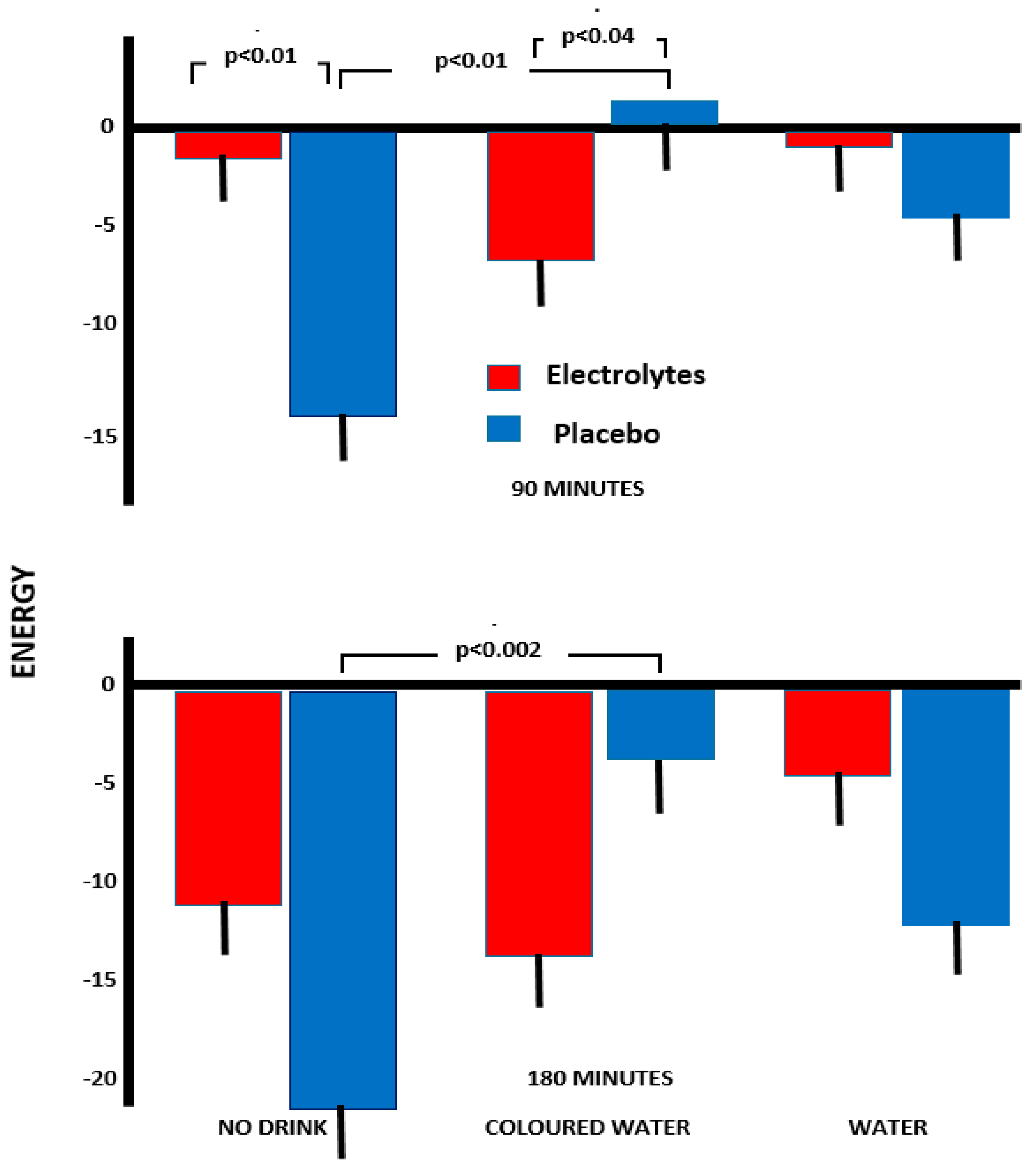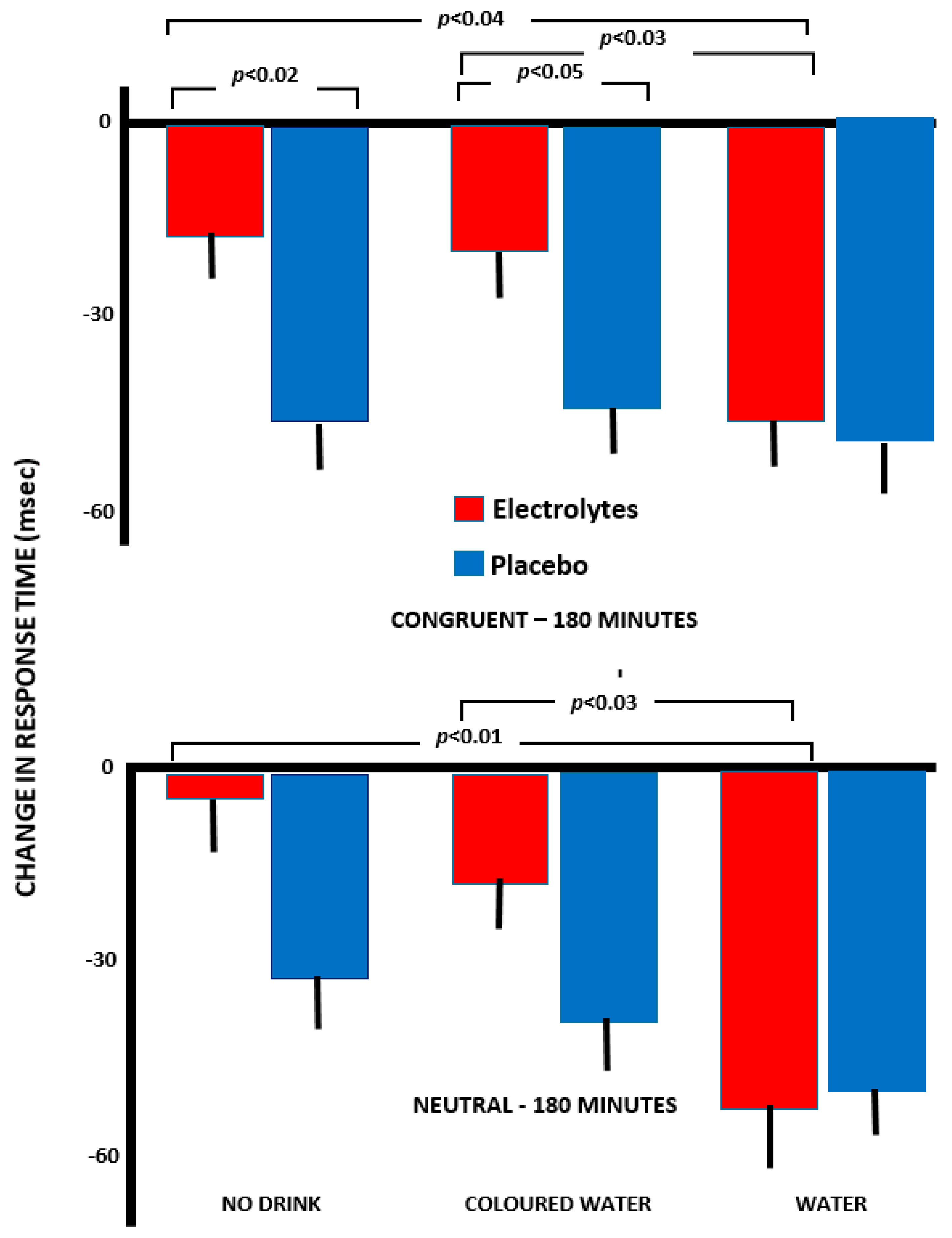The Effect of Hypo-Hydration on Mood and Cognition Is Influenced by Electrolyte in a Drink and Its Colour: A Randomised Trial
Abstract
1. Introduction
2. Materials and Methods
2.1. Subjects
2.2. Design
2.3. Procedure
2.4. Osmolality
2.5. Body Mass
2.6. Mood
2.7. Episodic Memory: Word-List Recall
2.8. Focused Attention: Arrow Flanker Test
2.9. Working Memory
2.10. Reaction Time
2.11. Data Analysis
3. Results
3.1. Effects of Interventions on Osmolality and Body Mass
Change in Hydration
3.2. The Influence of Six Interventions on Mood
3.2.1. Agreeable
3.2.2. Composure
3.2.3. Clearheaded
3.2.4. Energy
3.2.5. Elation
3.2.6. Confidence
3.3. The Effect of the Interventions upon Cognition
3.3.1. Arrow Flankers—Congruent Trials (<<<<<)
3.3.2. Incongruent Trials (<<><<)
3.3.3. Neutral Trials (□□<□□)
3.3.4. Memory
3.3.5. Serial Sevens
3.3.6. Reaction Times
4. Discussion
5. Conclusions
Supplementary Materials
Author Contributions
Funding
Conflicts of Interest
References
- Cheuvront, S.N.; Carter, R.; Sawka, M.N. Fluid balance and endurance exercise performance. Curr. Sports Med. Rep. 2003, 2, 202–208. [Google Scholar] [CrossRef] [PubMed]
- Benton, D.; Young, H. Do small differences in hydration status affect mood and mental performance? Nutr. Rev. 2015, 73 (Suppl. 2), 83–96. [Google Scholar] [CrossRef] [PubMed]
- Wittbrodt, M.T.; Millard-Stafford, M. Dehydration impairs cognitive performance: A meta-analysis. Med. Sci. Sports Exerc. 2018, 50, 2360–2368. [Google Scholar] [CrossRef] [PubMed]
- Benton, D.; Jenkins, K.T.; Watkins, H.T.; Young, H.A. Minor degree of hypohydration adversely influences cognition: A mediator analysis. Am. J. Clin. Nutr. 2016, 104, 603–612. [Google Scholar] [CrossRef] [PubMed]
- Watson, P.; Whale, A.; Mears, S.A.; Reyner, L.A.; Maughan, R.J. Mild hypohydration increases the frequency of driver errors during a prolonged, monotonous driving task. Physiol. Behav. 2015, 147, 313–318. [Google Scholar] [CrossRef] [PubMed]
- Benton, D.; Burgess, N. The effect of the consumption of water on the memory and attention of children. Appetite 2009, 53, 143–146. [Google Scholar] [CrossRef] [PubMed]
- Edmonds, C.J.; Burford, D. Should children drink more water: The effects of drinking water on cognition in children? Appetite 2009, 52, 776–779. [Google Scholar] [CrossRef] [PubMed]
- Edmonds, C.J.; Jeffes, B. Does having a drink help you think? 6–7-year-old children show improvements in cognitive performance from baseline to test after having a drink of water. Appetite 2009, 53, 469–472. [Google Scholar] [CrossRef]
- Benton, D. Dehydration influences mood and cognition: A plausible hypothesis? Nutrients 2011, 3, 555–573. [Google Scholar] [CrossRef]
- Lieberman, H.R. Hydration and cognition: A critical review and recommendations for future research. J. Am. Coll. Nutr. 2007, 26, 555S–561S. [Google Scholar] [CrossRef]
- Smeets, P.A.M.; Erkner, A.; de Graaf, C. Cephalic phase responses and appetite. Nutr. Rev. 2010, 68, 643–655. [Google Scholar] [CrossRef]
- Srivastava, R.K.; More, A.T. Some aesthetic considerations for over the-counter (OTC) pharmaceutical products. Int. J. Biotecnol. 2010, 11, 267–283. [Google Scholar] [CrossRef]
- G*Power: Statistical Power Analyses. Available online: http://www.psycho.uni-duesseldorf.de/abteilungen/aap/gpower3/who-we-are (accessed on 20 January 2019).
- McNair, D.M.; Lorr, M.; Droppleman, L.F. Revised Manual for the Profile of Mood States; Educational and Industrial Testing Services: San Diego, CA, USA, 1992. [Google Scholar]
- MRC Psycholinguistic Database. Available online: http://websites.psychology.uwa.edu.au/school/MRCDatabase/uwa_mrc.htm (accessed on 20 January 2019).
- Eriksen, B.A.; Eriksen, C.W. Effects of noise letters upon identification of a target letter in a non-search task. Percept. Psychophys. 1974, 16, 143–149. [Google Scholar] [CrossRef]
- Jensen, R. Individual differences in the hick paradigm. In Speed of Information—Processing and Intelligence; Vernon, P.A., Ed.; Ablex: Norwood, NJ, USA, 1987; pp. 101–175. [Google Scholar]
- Young, H.A.; Benton, D. Autonomic Adaptations mediate the effect of Hydration on Brain Functioning, Cognition and Mood: A Randomised Controlled Trial. Available online: https://www.researchgate.net/publication/326523750. (accessed on 15 July 2019).
- Johnson, J.; Clydesdale, F.M. Perceived Sweetness and Redness in Colored Sucrose Solutions. J. Food Sci. 1982, 47, 747–752. [Google Scholar] [CrossRef]
- Shankar, M.U.; Levitan, C.A.; Spence, C. Grape expectations: The role of cognitive influences in color-flavor interactions. Concious. Cogn. 2010, 19, 380–390. [Google Scholar] [CrossRef]
- Benton, D.; Young, H.A. Should a daily portion of fruit juice be recommended to help achieve five-a-day? Nutr. Rev. 2019, in press. [Google Scholar]
- Vilela, A.; Cosme, F. Drink Red: Phenolic Composition of Red Fruit Juices and Their Sensorial Acceptance. Beverages 2016, 2, 29. [Google Scholar] [CrossRef]
- Nokes, H.; Mack, G.W.; Shi, X.R.; Nadel, E.R. Role of osmolality and plasma volume during rehydration in humans. J. Appl. Physiol. 1985, 65, 325–331. [Google Scholar]
- Evans, G.H.; James, L.J.; Shirreffs, S.M.; Maughan, R.J. Optimizing the restoration and maintenance of fluid balance after exercise-induced dehydration. J. Appl. Physiol. 2017, 122, 945–951. [Google Scholar] [CrossRef]
- Armstrong, L.E.; Ganio, M.S.; Casa, D.J.; Lee, E.C.; McDermott, B.P.; Klau, J.F.; Jimenez, L.; Le Bellego, L.; Chevillotte, E.; Lieberman, H.R. Mild dehydration affects mood in healthy young women. J. Nutr. 2012, 142, 382–388. [Google Scholar] [CrossRef]
- Chang, T.; Ravi, N.; Plegue, M.A.; Sonneville, K.R.; Davis, M.M. Inadequate Hydration, BMI, and Obesity among US Adults: NHANES 2009–2012. Ann. Fam. Med. 2016, 14, 320–324. [Google Scholar] [CrossRef]
- Kempton, M.J.; Ettinger, U.; Foster, R.; Williams, S.C.R.; Calvert, G.A.; Hampshire, A.; Zelaya, F.O.; O’Gorman, R.L.; McMorris, T.; Owen, A.M.; et al. Dehydration affects brain structure and function in healthy adolescents. Hum. Brain Mapp 2011, 32, 71–79. [Google Scholar] [CrossRef]
- Perrier, E.; Vergne, S.; Klein, A.; Poupin, M.; Rondeau, P.; Le Bellego, L.; Armstrong, L.E.; Lang, F.; Stookey, J.; Tack, I. Hydration biomarkers in free-living adults with different levels of habitual fluid consumption. Brit. J. Nutr. 2013, 109, 1678–1687. [Google Scholar] [CrossRef]
- Liu, F.; Havens, J.; Yu, Q.; Wang, G.; Davisson, R.L.; Pickel, V.M.; Iadecola, C. The link between angiotensin II-mediated anxiety and mood disorders with NADPH oxidase-induced oxidative stress. Int. J. Physiol. Pathophysiol. Pharmacol. 2012, 4, 28–35. [Google Scholar]
- Morales-Medina, J.C.; Witchey, S.K.; Caldwell, H.K. The Role of Vasopressin in Anxiety and Depression. In Melatonin, Neuroprotective Agents and Antidepressant Therapy; López-Muñoz, F., Srinivasan, V., de Berardis, D., Álamo, C., Kato, T., Eds.; Springer: New Delhi, India, 2016; pp. 667–685. [Google Scholar]
- Raasch, W.; Witmershaus, C.; Dendorfer, A.; Voges, I.; Pahlke, F.; Dodt, C.; Dominiak, P.; Johren, O. Angiotensin II Inhibition Reduces Stress Sensitivity of Hypothalamo-Pituitary-Adrenal Axis in Spontaneously Hypertensive Rats. Endocrinology 2006, 147, 3539–3546. [Google Scholar] [CrossRef]
- Vian, J.; Pereira, C.; Chavarria, V.; Köhler, C.; Stubbs, B.; Quevedo, J.; Kim, S.-W.; Carvalho, A.F.; Berk, M.; Fernandes, B.S. The renin–angiotensin system: A possible new target for depression. BMC Med. 2017, 15, 144. [Google Scholar] [CrossRef]
- Murck, H.; Held, K.; Ziegenbein, M.; Künzel, H.; Koch, K.; Steiger, A. The Renin-Angiotensin-Aldosterone system in patients with depression compared to controls—A sleep endocrine study. BMC Psychiat. 2003, 3, 15. [Google Scholar] [CrossRef]
- Murck, H.; Schuessler, P.; Steiger, A. Renin-Angiotensin-Aldosterone System: The forgotten stress hormone system: Relationship to depression and sleep. Pharmacopsychiatry 2012, 45, 83–95. [Google Scholar] [CrossRef]
- Emanuel, E.; Geroldi, D.; Minoretti, P.; Coen, E.; Politi, P. Increased Plasma Aldosterone in Patients with Clinical Depression Arch. Med. Res. 2005, 36, 544–548. [Google Scholar]
- Hallberg, L.; Westrin, A.; Isaksson, A.; Janelidze, S.; Traskman-Bendz, L.; Brundin, L. Decreased aldosterone in the plasma of suicide attempters with major depressive disorder. Psychiat. Res. 2011, 187, 135–139. [Google Scholar] [CrossRef]
- Benton, D.; Braun, H.; Cobo, J.C.; Edmonds, C.; Elmadfa, L.; El-Sharkawy, A.; Feehally, J.; Gellert, R.; Holdsworth, J.; Kapsokefalou, M.; et al. Executive summary and conclusions from the European Hydration Institute expert conference on human hydration, health, and performance. Nutr. Rev. 2015, 73, 148–150. [Google Scholar] [CrossRef]
- Benton, D. To establish the parameters of optimal nutrition do we need to consider psychological in addition to physiological parameters? Mol. Nutr. Food Res. 2013, 57, 6–19. [Google Scholar] [CrossRef]




| Intervention | Baseline Osmolality | Range | Change Osmolality | Range | Percent Change Body Mass | Range |
|---|---|---|---|---|---|---|
| No Drink | 651.3 (345.5) | 94–1115 | +101.4 (159.4) | −204–421 | −0.67 (0.26) | −1.24–−0.16 |
| Electrolyte | n = 26 | n = 21 abcd | n = 25 abcd | |||
| No Drink | 609.9 (257.2) | 135–1032 | +146.5 (160.1) | −117–508 | −0.66 (0.20) | −1.35–−0.42 |
| Placebo | n = 26 | n = 25 efgh | n = 27 efgh | |||
| Coloured Water | 640.0 (298.8) | 152–1159 | −18.7 (193.9) | −314–438 | −0.41 (0.30) | −1.28–+0.13 |
| Electrolyte | n = 30 | n = 27 ae | n = 30 ae | |||
| Coloured Water | 620.4 (283.1) | 128–1058 | −20.6 (117.9) | −364–313 | −0.41 (0.33) | −1.18–+0.09 |
| Placebo | n = 29 | n = 27 bf | n = 28 bf | |||
| Water | 672.1 (308.8) | 95–1108 | −32.1 (245.3) | −566–405 | −0.43 (0.35) | −1.42–+0.02 |
| Electrolyte | n = 27 | n = 27 cg | n = 27 cg | |||
| Water | 668.5 (284.5) | 131–1163 | −0.59 (195.9) | −401–315 | 0.41 (0.24) | −0.80–+0.15 |
| Placebo | n = 29 | n = 27 dh | n = 28 dh |
© 2019 by the authors. Licensee MDPI, Basel, Switzerland. This article is an open access article distributed under the terms and conditions of the Creative Commons Attribution (CC BY) license (http://creativecommons.org/licenses/by/4.0/).
Share and Cite
Cousins, A.L.; Young, H.A.; Thomas, A.G.; Benton, D. The Effect of Hypo-Hydration on Mood and Cognition Is Influenced by Electrolyte in a Drink and Its Colour: A Randomised Trial. Nutrients 2019, 11, 2002. https://doi.org/10.3390/nu11092002
Cousins AL, Young HA, Thomas AG, Benton D. The Effect of Hypo-Hydration on Mood and Cognition Is Influenced by Electrolyte in a Drink and Its Colour: A Randomised Trial. Nutrients. 2019; 11(9):2002. https://doi.org/10.3390/nu11092002
Chicago/Turabian StyleCousins, Alecia L., Hayley A. Young, Andrew G. Thomas, and David Benton. 2019. "The Effect of Hypo-Hydration on Mood and Cognition Is Influenced by Electrolyte in a Drink and Its Colour: A Randomised Trial" Nutrients 11, no. 9: 2002. https://doi.org/10.3390/nu11092002
APA StyleCousins, A. L., Young, H. A., Thomas, A. G., & Benton, D. (2019). The Effect of Hypo-Hydration on Mood and Cognition Is Influenced by Electrolyte in a Drink and Its Colour: A Randomised Trial. Nutrients, 11(9), 2002. https://doi.org/10.3390/nu11092002





